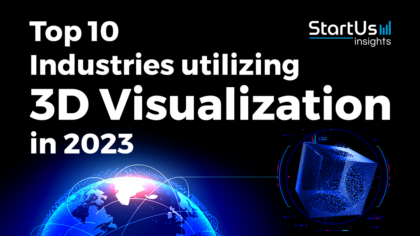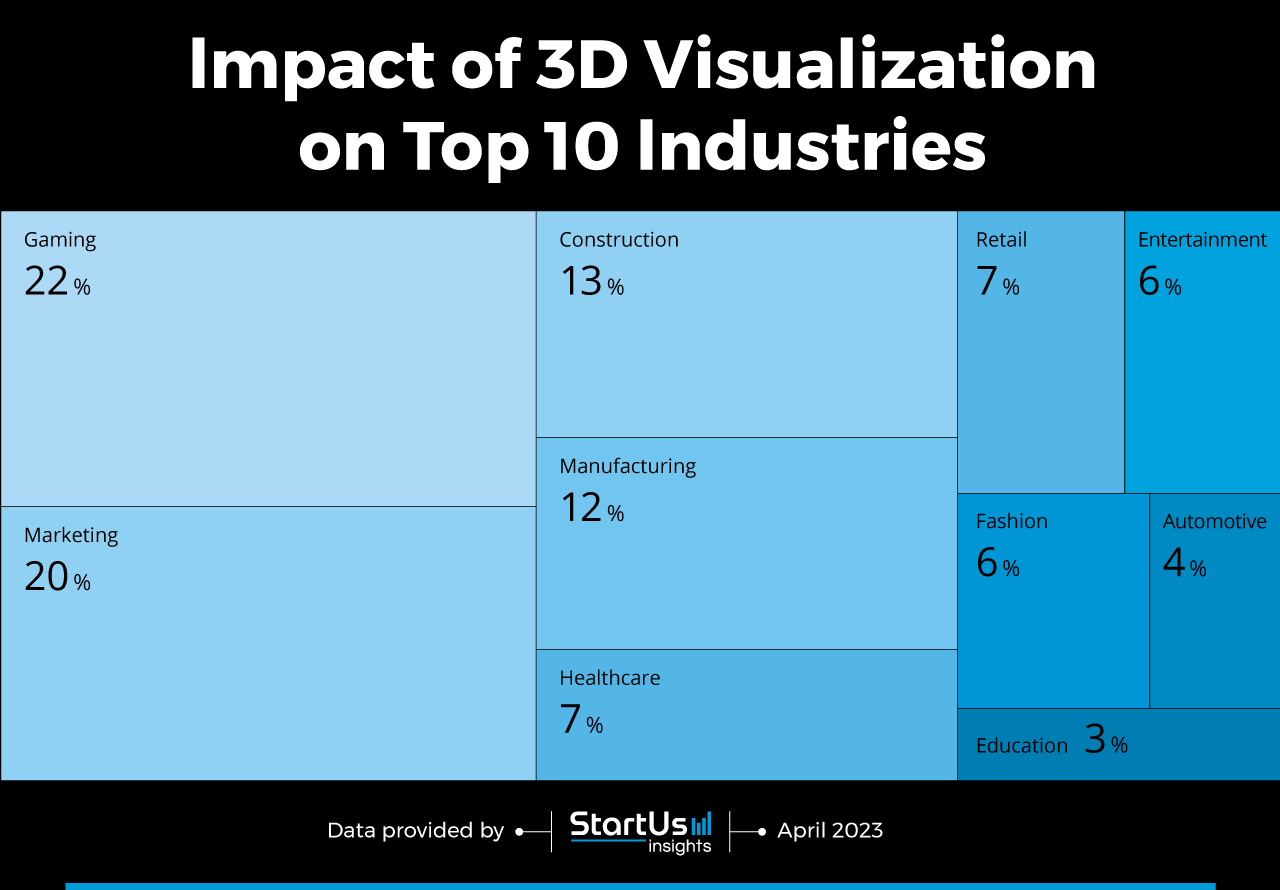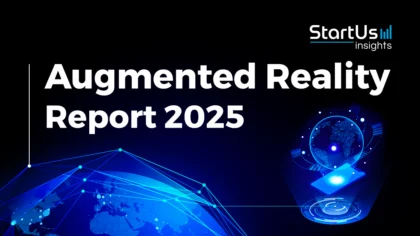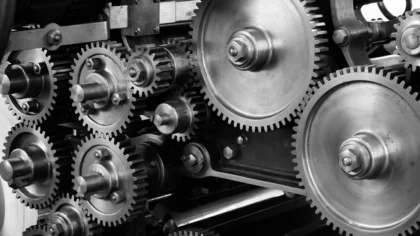Accelerate Productivity in 2025
Reignite Growth Despite the Global Slowdown
3D visualization software enables interactive experiences by creating three-dimensional digital models of objects, spaces, or structures. It provides a realistic and interactive representation of such models, enabling better visualization, communication, and decision-making in fields such as architecture, engineering, and product design.
This article offers you innovation insights based on our analysis of 3000+ 3D visualization software startups and their impact on 10 industries. They range from gaming and marketing to automotive and education, among other sectors. Read more to explore the impact of 3D visualization on various industries and how they advance your business.
Tree Map reveals the Impact of 3D Visualization Software on 10 Industries
The Tree Map below illustrates the impact of 3D visualization on 10 industries in 2023 and 2024. 3D visualization tools finds diverse applications across a range of industries. The gaming industry uses it to create immersive experiences through 3D game assets, characters, and environments. Marketing and retail sectors utilize 3D visualization for prototyping, creating visualizations for campaigns and store layouts.
For construction and manufacturing, 3D visualization companies create virtual prototypes and simulations of infrastructure and products, saving time and costs associated with physical prototyping. Healthcare relies on this technology for medical imaging and treatment planning. On the other hand, the automotive industry leverages it in the design and engineering of vehicles while fashion brands implement virtual prototyping and digital fashion shows using it.
Finally, the education industry utilizes 3D visualization to create engaging virtual renditions of complex concepts to enhance learning.
Global Startup Heat Map covers 3010 3D Visualization Startups & Scaleups
The Global Startup Heat Map below highlights the global distribution of the 3010 exemplary startups & scaleups that we analyzed for this research. Created through the StartUs Insights Discovery Platform that covers 3 790 000+ startups & scaleups globally, the Heat Map reveals that Western Europe and the US have a high concentration of 3D visualization startups, followed by India.
Below, you get to meet 10 out of these 3010 promising startups & scaleups as well as the solutions they develop. These 3D visualization software startups are hand-picked based on criteria such as founding year, location, funding raised & more. Depending on your specific needs, your top picks might look entirely different.
Impact of 3D Visualization Tools on 10 Industries
1. Gaming
3D visualization enables gamers to immerse themselves in virtual worlds and interact with lifelike characters and environments. The use of advanced graphics, lighting, and animation techniques creates realistic environments and characters that enhance the gaming experience. To aid this, startups are implementing 3D visualization in gaming by exploring augmented reality (AR) and virtual reality (VR).
Some startups are developing software that enables players to interact with virtual environments and characters in more intuitive and natural ways. They also leverage novel techniques for rendering and displaying 3D graphics, such as cloud-based gaming and real-time ray tracing. These innovations enhance the player’s experience and also open up new possibilities for game design and storytelling.
MANU develops a 3D Video Game Development Tool
Hungarian startup MANU offers an eponymous video game development tool that allows developers to create 3D arcade games with minimal to no coding. The software tool uses a combination of triggers and animations to let developers decide and implement game logic and behavior.
It also allows users to import their own 3D models and textures, or use the built-in assets and shaders. MANU’s software supports various post-processing effects and lighting features to enhance the visual quality of the games. This enables rapid prototyping and testing of game ideas and also lowers the entry barrier for game development.
2. Marketing
Businesses and advertisers use 3D visualization to showcase their products or services in a visually appealing and interactive way. Brands create realistic and immersive environments, enabling consumers to experience products virtually and enhancing their decision-making process. This garners customer attention, particularly in industries like real estate, fashion, and automotive where the visual aspect of a product is crucial in driving sales.
3D visualization startups are using AR and VR to create immersive experiences for consumers, while others are using 3D models to augment physical models for marketing. Additionally, some startups are creating AI-powered 3D rendering platforms to help businesses create photo-realistic visualizations quickly and efficiently.
Visao delivers 3D Marketing Experiences
Visao is a Canadian startup that helps businesses create immersive marketing experiences for their customers using 3D product models and AR. The startup’s platform allows users to interact with realistic, animated 3D models of products on websites, online ads, or applications. It is also easy to integrate with platforms, cross-platform compatible, and secure.
Visao’s 3D marketing increases customer conversion, click-through rates, and purchases, as well as reduces product returns and pre-purchase anxiety. This, in turn, allows businesses to modernize their brand image and communicate complex product information through memorable experiences to their audience.
3. Construction
Architects, engineers, and contractors create and share digital models of their designs using 3D visualization. It allows stakeholders to better understand construction site plans, make more informed decisions, and identify and address potential issues before construction begins. Companies are using building information modeling (BIM) to allow architects, engineers, and construction professionals to create and share detailed 3D models of building designs, enabling collaborative design and construction.
Some startups are using VR and AR to create immersive and interactive building tours for potential buyers and construction companies before construction commences. Others are using drones and light detection and ranging (LiDAR) to capture accurate site data, which they use to create detailed 3D models. These advances in 3D visualization are driving collaboration, reducing costs, and improving the overall efficiency of construction projects.
mimAR offers 3D Architectural Rendering
Pakistani startup mimAR provides rendering services for real estate developers and construction companies. The startup creates realistic and immersive 3D models of architectural projects, such as 3D renders, cinematic videos, site plans, construction site visualization, and terrain mapping. Customers access these renders using a headset or a mobile device. Through these, mimAR helps clients communicate their ideas to the developers, avoiding confusion and attracting potential buyers while saving time and money.
4. Manufacturing
Within the manufacturing industry, 3D visualization allows for the creation of detailed models of products, equipment, and facilities. It enables manufacturers to visualize and analyze data, identify potential issues, and streamline production. Startups are leveraging technologies such as augmented reality, virtual reality, and digital twins to create immersive and interactive 3D models.
This enables manufacturers to visualize and streamline their operations. They use these 3D models for product design, prototyping, and process optimization. As a result, 3D visualizations significantly improve factory efficiency and production line visibility.
HNA Live delivers 3D Rendering for Manufacturing
US-based startup HNA Live makes a cloud-based 3D rendering platform for the manufacturing industry. By leveraging LiDAR, the startup provides precise measurements and creates 3D models of manufacturing processes, including plant movement, working parts, and entire building operations.
The platform also allows executives to access real-time operational data remotely, compare plants and operations globally, and make informed decisions based on actionable insights. It uses 3D graphics to visualize the efficiency and condition of factory machinery, allowing workers to initiate predictive maintenance. HNA Live’s platform helps manufacturers reduce waste, increase efficiency, and improve worker safety.
5. Healthcare
Physicians utilize 3D visualization tools to provide visual representations of scanned body parts via virtual models and offer depth and nuance to static two-dimensional medical images. This improves diagnoses, narrows surgical operation learning curves, reduces operational costs, and shortens image acquisition times.
Such solutions also facilitate education and surgical planning by delivering insights into pathological changes and patient-specific organ anatomy. Many startups are using artificial intelligence (AI) to optimize image management, processing, and analysis, creating interactive 3D medical animations for communication and marketing.
Hospitals are also leveraging imaging platforms that use data from magnetic resonance imaging (MRI) and computed tomography angiography (CTA) to create 3D images of the heart.
MiDiVi develops 3D Medical Modeling Software
MiDiVi is a Chinese startup that creates 3D modeling software for healthcare professionals and hospitals. It enables doctors to create 3D models of computer tomography (CT) images. The software also allows users to view the models of MRI scans using mixed reality (MR) devices. Further, it supports holographic image visualization and offers AR-assisted surgical guidance over the cloud. MiDiVi’s 3D visualization software improves surgical training, patient communication, and case-by-case analysis of medical scenarios, enhancing clinical efficiency and accuracy.

6. Retail
3D visualization allows retailers to showcase products in different angles, colors, sizes, and environments, offering customers a better understanding of the product’s features, quality, and fit. 3D visualization also helps retailers reduce costs and time associated with product photography, inventory management, and returns.
Product models offer retailers a more accurate representation of their inventory, increasing the efficiency of product placement, restocking, and order fulfillment. Further, these models make it easy to identify product defects or damage and determine the best course of action for repair or replacement.
Many startups are leveraging 3D visualizations to create web 3D viewers, product configurators, AR tryouts, and virtual assistants. These solutions enable immersive commerce and boost customer engagement, satisfaction, and loyalty, leading to higher conversion rates and sales.
Expivi makes a 3D eCommerce Platform
Dutch startup Expivi offers a 3D eCommerce platform to empower online businesses. The platform features a code-free 3D configurator that allows businesses to create and use immersive 3D shopping and marketing experiences using AR. Expivi allows buyers to customize products in a 360 degrees view, change color, material, size, and other features, and see real-time pricing.
It also enables them to virtually try out products in their own environment using AR, reducing product returns and increasing sales. The platform operates on a software-as-a-service (SaaS) model and integrates with various eCommerce platforms. Consequently, Expivi’s platform boosts conversion rates and reduces marketing costs while improving customer satisfaction.
7. Entertainment
The entertainment industry uses 3D imagery to create realistic and immersive experiences for audiences. 3D models, animations, and effects generated using various software tools and techniques are widely used in films, TV, games, and AR applications. 3D visualization also finds use in film and TV for special effects, virtual backgrounds, and virtual sets.
This allows filmmakers to create realistic scenes and environments that are otherwise difficult or expensive to create in real life. Public attractions, such as theme parks and museums, are also employing AR and VR to create immersive rides and attractions. After the pandemic, startups are integrating 3D visualization to create immersive and interactive environments for concerts, conferences, and other events.
PentoPix advances Text to Storyboard Conversion
PentoPix is a UK-based startup that offers an AI-based video creation platform, which converts text into animated 3D storyboards. The startup combines natural language processing (NLP) and computer vision to analyze the script and generate realistic scenes, characters, and actions.
This simplifies the complex and expensive process of video pre-production and enables storytellers and small-scale studios to create animated content. It negates the need for scouting and recruiting illustrators and visual effects artists, reducing the production budget significantly. The platform also allows creators to save time and money, pitch their ideas more effectively, and optimize production planning and budgeting.
8. Fashion
Designers and potential customers create and view realistic digital models of fashion products such as clothes, apparel, and accessories using 3D visualization. It is becoming an integral part of the fashion industry as it offers benefits such as cost reduction, faster production, and customization. Startups are innovating in this field by developing platforms and tools that simplify 3D design, simulation, rendering, and collaboration.
Clothing retailers also design their store layouts and visual merchandising displays using 3D modeling. This helps to optimize space utilization and create an appealing shopping environment for customers. Startups are also working on product configurators that allow customers to customize and personalize their purchases and try on their clothes and apparel on virtual models. This creates a more engaging and personalized shopping experience.
StyleScan develops a 3D Virtual Merchandising Tool
US-based startup StyleScan offers a 3D virtual merchandising tool for fashion brands and retailers. Using machine learning and image processing, it converts images into 3D digital wearables. This enables buyers to try on the clothes virtually regardless of shapes, sizes, and ethnicities. StyleScan’s tool also enables consumers to mix and match items from their inventory, style full outfits, and preview how they look to improve the buying experience.
Further, the tool enables users to use AR to view jewelry and accessories in their actual environment, reducing product return rates. StyleScan’s tool increases customer engagement and conversions, reduces changing room costs and waste, and promotes inclusivity in the fashion industry.
9. Automotive
Unlike traditional 2D renders and drawings, 3D visualization enables designers, engineers, and customers to interact with realistic models of vehicles before they are manufactured. It enhances the design process, reduces costs and errors, and improves communication and collaboration. Automotive manufacturers also leverage virtual showrooms to create immersive experiences for potential buyers.
Many startups are working on automotive digital twins to create virtual models of vehicles and test their aerodynamics, crashworthiness, and other performance metrics. 3D rendering platforms also allow designers to create, modify, and test detailed virtual models of engines and other automotive components in real time.
Morai provides an Automotive Simulation Platform
Morai is a South Korean startup that provides a simulation platform for autonomous driving systems. It uses 3D digital twins to create realistic and diverse test environments for verifying the safety and reliability of self-driving vehicles. Morai’s platform evaluates whether a company’s advanced driver assistance system (ADAS) meets all safety standards set by the simulator before applying to a commercial vehicle.
The platform also supports cloud-based simulation, allowing businesses to run multiple simulations concurrently and cost-effectively. The startup helps car manufacturers accelerate the development and deployment of autonomous driving solutions and hence increase road safety.
10. Education
Institutions and e-learning platforms are employing 3D visualization to enhance learning outcomes, engagement, and motivation for students and teachers. Educational institutes use it for various purposes, including simulating experiments, exploring historical sites, creating art projects, or visualizing complex concepts. Startups are developing hologram solutions based on VR and AR that integrate into the classroom experience.
This provides different levels of immersive learning and interactivity for the students, depending on their needs and preferences. Startups are also working on virtual classroom setups such that students attend classes from the comfort of their homes and still gain quality education.
Immersivevision Technology facilitates 3D Immersive Learning
Indian startup Immersivevision Technology offers SimuLab and Cadaviz, its 3D virtual education solutions. SimuLab is a 3D virtual science practical lab that allows students to learn and perform science experiments without the safety hazards of scientific equipment and chemicals. Cadaviz is a human-sized virtual dissection table that allows medical students to interact with and study human anatomy.
The startup uses AR and VR experiences as well as computer vision to create immersive and interactive modules. This makes lab-based science education affordable, accessible, and engaging. Immersivevision Technology allows students to visualize concepts easily, perform experiments with gamification, and track learning, enhancing student learning outcomes and retention.
Discover All 3D Visualization Tools & Companies
3D visualization software will see continued integration in various aspects of daily life. However, it is computationally intensive, requiring high-end hardware and software to create and render complex models. This makes it difficult for small and medium businesses to leverage 3D visualization without incurring massive expenses. Startups solve this issue by leveraging cloud computing and distributed processing. These technologies, along with other innovations in the field, will make 3D visualization more accessible to a wider audience. Get in touch to identify specific 3D visualization companies & solutions that advance your business!









